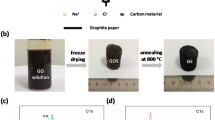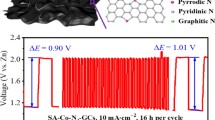Abstract
In this study, a nitrogen and sulfur co-doped sodium titanium phosphate/hole graphene (N,S-NTP/rHGO) was synthesized by one-step hydrothermal method using thiourea as N/S source. The microstructure characterization confirms that N and S heteroatoms have been integrated into the graphene skeleton. The electrochemistry and electrosorption properties of the N,S-NTP/rHGO electrodes were investigated for hybrid capacitor deionization (HCDI). The results indicate that the specific capacitance of N,S-NTP/rHGO electrodes can reach 530.46 F g−1 at a scan rate of 0.2 mV s−1, which is 33.8% higher than that of the sample without doping. Moreover, the HCDI cell based on the N,S-NTP/rHGO-2 shows a high desalination capacity of 36.87 mg g−1 and a rapid ion removal rate of 0.66 mg g−1 s−1, which is more than twice as high as the sample without doping (0.3 mg g−1 s−1) at an initial NaCl concentration of 800 mg L−1 and applied voltage of 1.4 V. Further, the N,S-NTP/rHGO electrode exhibits excellent regeneration ability. Therefore, this study suggests that as-prepared N,S-NTP/rHGO composite exhibits a great potential application for high-performance HCDI systems.











Similar content being viewed by others
References
Oren Y (2008) Capacitive deionization (CDI) for desalination and water treatment—past, present and future (a review). Desalination 228:10–29
Rui N, Li H, Ma Y, He L, Jin L (2015) An insight into the improved capacitive deionization performance of activated carbon treated by sulfuric acid. Electrochim Acta 176:755–762
Bar-Zeev E, Elimelech M (2014) Reverse osmosis biofilm dispersal by osmotic back-flushing: cleaning via substratum perforation. Environ Sci Technol Lett 1:162–166
Greenlee LF, Lawler DF, Freeman BD, Marrot B, Moulin P (2009) Reverse osmosis desalination: water sources, technology, and today’s challenges. Water Res 43:2317–2348
Al-Karaghouli A, Kazmerski LL (2013) Energy consumption and water production cost of conventional and renewable-energy-powered desalination processes. Renew Sustain Energy Rev 24:343–356
Alkhudhiri A, Darwish N, Hilal N (2012) Membrane distillation: a comprehensive review. Desalination 287:2–18
Sadrzadeh M, Mohammadi T (2008) Sea water desalination using electrodialysis. Desalination 221:440–447
Schlumpberger S, Lu NB, Suss ME, Bazant MZ (2015) Scalable and continuous water deionization by shock electrodialysis. Environ Sci Technol Lett 2:367–372
Elimelech M, Phillip WA (2011) The future of seawater desalination: energy, technology, and the environment. Science 333:712–717
Porada S, Borchardt L, Oschatz M, Bryjak M, Atchison J, Keesman K, Kaskel S, Biesheuvel P, Presser V (2013) Direct prediction of the desalination performance of porous carbon electrodes for capacitive deionization. Energy Environ Sci 6:3700–3712
Porada S, Zhao R, Van Der Wal A, Presser V, Biesheuvel P (2013) Review on the science and technology of water desalination by capacitive deionization. Prog Mater Sci 58:1388–1442
Welgemoed T, Schutte C (2005) Capacitive deionization technology™: an alternative desalination solution. Desalination 183:327–340
Avraham E, Noked M, Bouhadana Y, Soffer A, Aurbach D (2010) Limitations of charge efficiency in capacitive deionization processes III: the behavior of surface oxidized activated carbon electrodes. Electrochim Acta 56:441–447
Barbieri O, Hahn M, Herzog A, Kötz R (2005) Capacitance limits of high surface area activated carbons for double layer capacitors. Carbon 43:1303–1310
Li L, Zou L, Song H, Morris G (2009) Ordered mesoporous carbons synthesized by a modified sol–gel process for electrosorptive removal of sodium chloride. Carbon 47:775–781
Lee J, Kim S, Kim C, Yoon J (2014) Hybrid capacitive deionization to enhance the desalination performance of capacitive techniques. Energy Environ Sci 7:3683–3689
Byles BW, Cullen DA, More KL, Pomerantseva E (2018) Tunnel structured manganese oxide nanowires as redox active electrodes for hybrid capacitive deionization. Nano Energy 44:476–488
Kim S, Lee J, Kang JS, Jo K, Kim S, Sung Y-E, Yoon J (2015) Lithium recovery from brine using a λ-MnO2/activated carbon hybrid supercapacitor system. Chemosphere 125:50–56
Wu T, Wang G, Wang S, Zhan F, Fu Y, Qao H, Qiu J (2018) Highly stable hybrid capacitive deionization with a MnO2 anode and a positively charged cathode. Environ Technol Lett 5(2):98–102
Zhou F, Gao T, Luo M, Li H (2018) Heterostructured graphene@ Na4Ti9O20 nanotubes for asymmetrical capacitive deionization with ultrahigh desalination capacity. Chem Eng J 343:8–15
Kim S, Lee J, Kim C, Yoon J (2016) Na 2 FeP 2 O 7 as a novel material for hybrid capacitive deionization. Electrochim Acta 203:265–271
Han C, Meng Q, Cao B, Tian G (2019) Enhanced hybrid capacitive deionization performance by sodium titanium phosphate/reduced porous graphene oxide composites. ACS Omega 4:11455–11463
Zhang L, Wang X, Deng W, Zang X, Liu C, Li C, Chen J, Xue M, Li R, Pan F (2017) An open holey structure enhanced rate capability in a NaTi2(PO4)3/C nanocomposite and provided ultralong-life sodium-ion storage. Nanoscale 10(3):958–963
Cao J, Wang Y, Wang L, Yu F, Ma J (2019) Na3V2 (PO4) 3@ C as faradaic electrodes in capacitive deionization for high-performance desalination. Nano Lett 19:823–828
Liang X, Ou X, Zheng F, Pan Q, Xiong X, Hu R, Yang C, Liu M (2017) Surface modification of Na3V2 (PO4) 3 by nitrogen and sulfur dual-doped carbon layer with advanced sodium storage property. ACS Appl Mater Interfaces 9:13151–13162
Yang Z, Qian K, Lv J, Yan W, Liu J, Ai J, Zhang Y, Guo T, Zhou X, Xu S (2016) Encapsulation of Fe 3 O 4 nanoparticles into N, S co-doped graphene sheets with greatly enhanced electrochemical performance. Sci Rep 6:27957
Pei J, Geng H, Ang H, Zhang L, Wei H, Cao X, Zheng J, Gu H (2018) Three-dimensional nitrogen and sulfur co-doped holey-reduced graphene oxide frameworks anchored with MoO2 nanodots for advanced rechargeable lithium-ion batteries. Nanotechnology 29:295404. https://doi.org/10.1088/1361-6528/aac02c
Marcano DC, Kosynkin DV, Berlin JM, Sinitskii A, Sun Z, Slesarev A, Alemany LB, Lu W, Tour JM (2010) Improved synthesis of graphene oxide. ACS Nano 4:4806–4814
Yuxi X, Kaixuan S, Chun L, Gaoquan S (2010) Self-assembled graphene hydrogel via a one-step hydrothermal process. ACS Nano 4:4324–4330
Razmjooei F, Singh KP, Song MY, Yu JS (2014) Enhanced electrocatalytic activity due to additional phosphorous doping in nitrogen and sulfur-doped graphene: a comprehensive study. Carbon 78:257–267
Chen J, Zhang H, Liu P, Li Y, Li G, An T, Zhao H (2015) Thiourea sole doping reagent approach for controllable N, S co-doping of pre-synthesized large-sized carbon nanospheres as electrocatalyst for oxygen reduction reaction. Carbon 92:339–347
Gu W, Sevilla M, Magasinski A, Fuertes AB, Yushin G (2013) Sulfur-containing activated carbons with greatly reduced content of bottle neck pores for double-layer capacitors: a case study for pseudocapacitance detection. Energy Environ Sci 6:2465–2476
Béguin F, Presser V, Balducci A, Frackowiak E (2014) Carbons and electrolytes for advanced supercapacitors. Adv Mater 26:2219–2251
Lee Y-H, Chang K-H, Hu C-C (2013) Differentiate the pseudocapacitance and double-layer capacitance contributions for nitrogen-doped reduced graphene oxide in acidic and alkaline electrolytes. J Power Sources 227:300–308
Yang S, Zhi L, Tang K, Feng X, Maier J, Müllen K (2012) Efficient synthesis of heteroatom (N or S)-doped graphene based on ultrathin graphene oxide-porous silica sheets for oxygen reduction reactions. Adv Funct Mater 22:3634–3640
Roh H-K, Kim M-S, Chung KY, Ulaganathan M, Aravindan V, Madhavi S, Roh KC, Kim K-B (2017) A chemically bonded NaTi 2 (PO 4) 3/rGO microsphere composite as a high-rate insertion anode for sodium-ion capacitors. J Mater Chem A 5:17506–17516
Zhi J, Wang Y, Deng S, Hu A (2014) Study on the relation between pore size and supercapacitance in mesoporous carbon electrodes with silica-supported carbon nanomembranes. RSC Adv 4:40296–40300
Zou L, Li L, Song H, Morris G (2008) Using mesoporous carbon electrodes for brackish water desalination. Water Res 42:2340–2348
Mohamed AI, Whitacre J (2017) Capacity fade of NaTi2 (PO4) 3 in aqueous electrolyte solutions: relating pH increases to long term stability. Electrochim Acta 235:730–739
Li-Feng C, Xu-Dong Z, Hai-Wei L, Mingguang K, Qing-Fang G, Ping C, Zhen-Yu W, Shu-Hong Y (2012) Synthesis of nitrogen-doped porous carbon nanofibers as an efficient electrode material for supercapacitors. ACS Nano 6:7092–7102
Yan J, Wang Q, Wei T, Fan Z (2014) Recent advances in design and fabrication of electrochemical supercapacitors with high energy densities. Adv Energy Mater 4:1300816
Yang C, Li W, Yang Z, Gu L, Yu Y (2015) Nanoconfined antimony in sulfur and nitrogen co-doped three-dimensionally (3D) interconnected macroporous carbon for high-performance sodium-ion batteries. Nano Energy 18:12–19
Acknowledgements
It is a pleasure to acknowledge the financial support of this research by the National Natural Science Foundation of China (51372011) and the China Scholarship Council (201506880029).
Author information
Authors and Affiliations
Corresponding authors
Ethics declarations
Conflict of interest
The authors declare that they have no conflict of interest.
Additional information
Publisher's Note
Springer Nature remains neutral with regard to jurisdictional claims in published maps and institutional affiliations.
Rights and permissions
About this article
Cite this article
Liang, S., Han, C., Meng, Q. et al. Nitrogen and sulfur co-doped NaTi2(PO4)3/hole graphene composite as high-performance electrosorption electrodes for hybrid capacitive deionization. J Mater Sci 55, 6017–6029 (2020). https://doi.org/10.1007/s10853-020-04426-8
Received:
Accepted:
Published:
Issue Date:
DOI: https://doi.org/10.1007/s10853-020-04426-8




